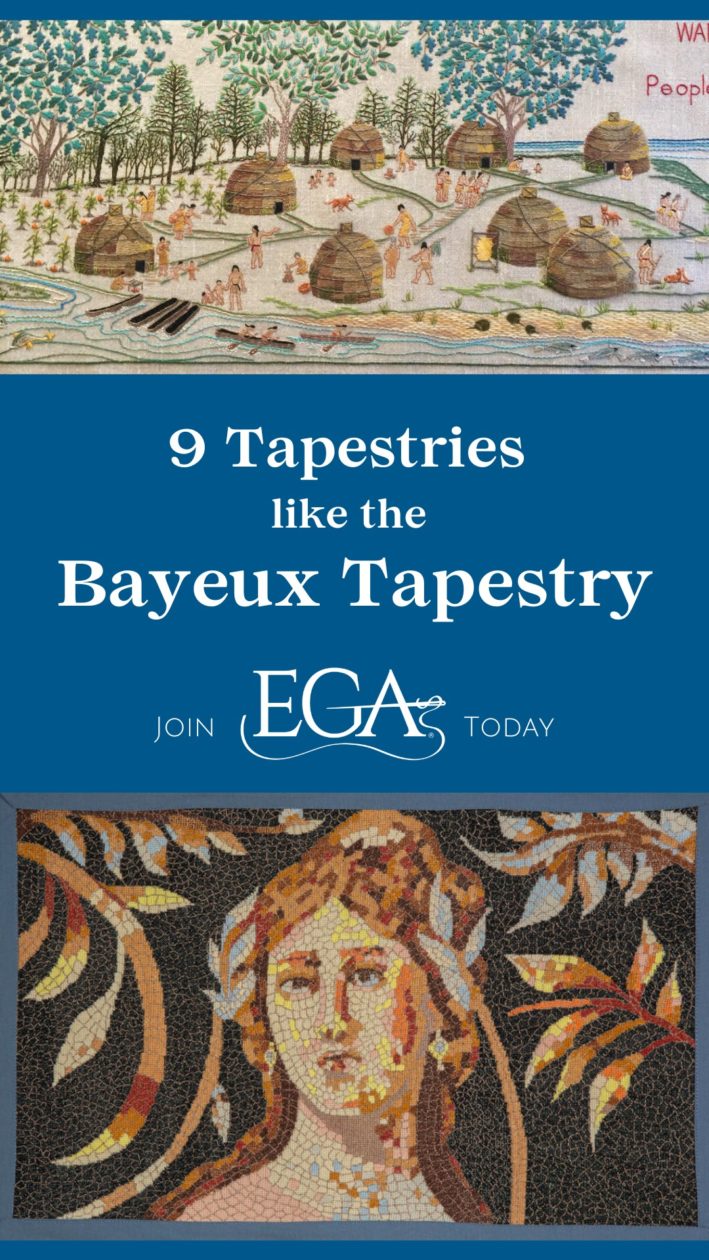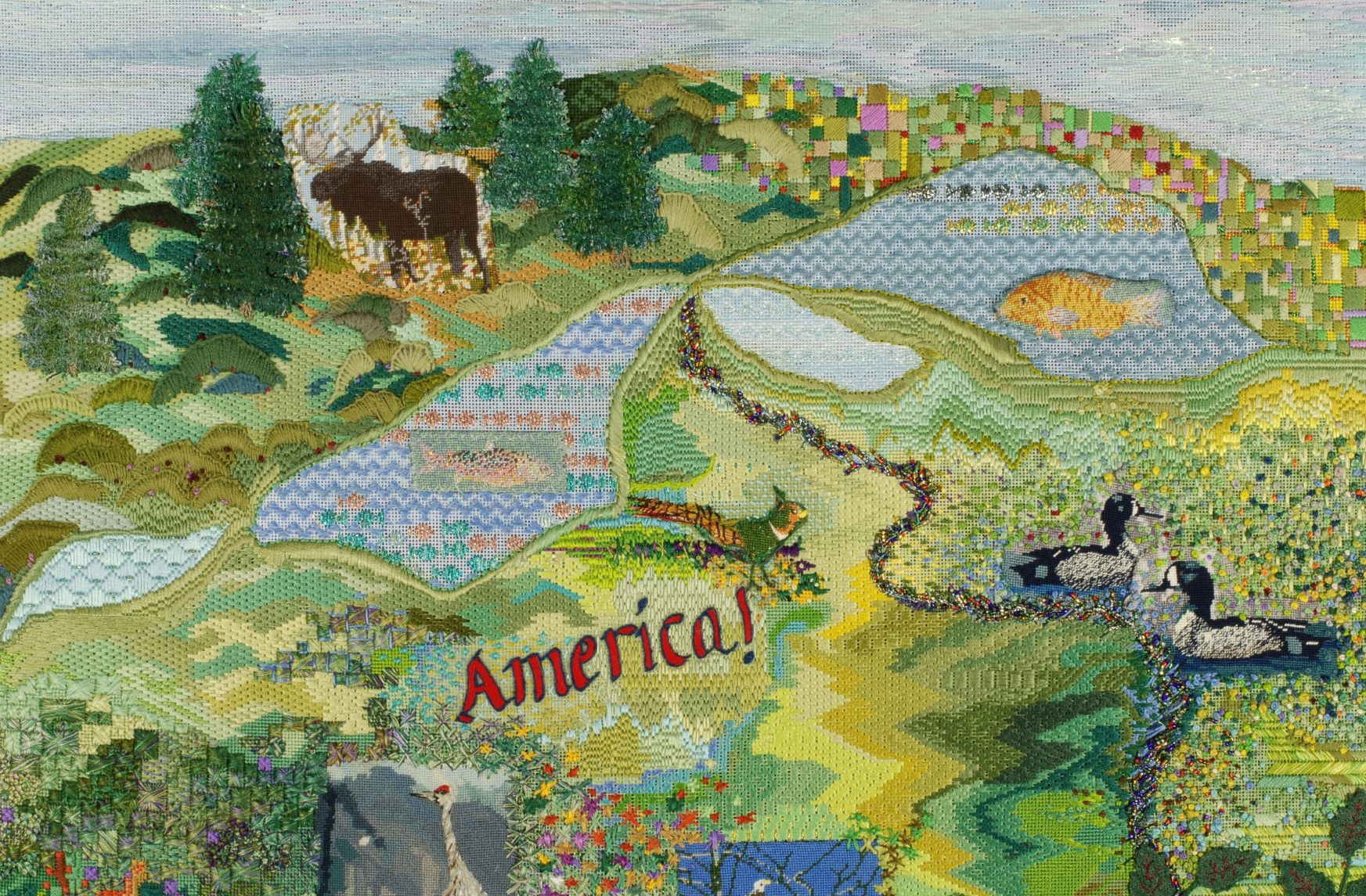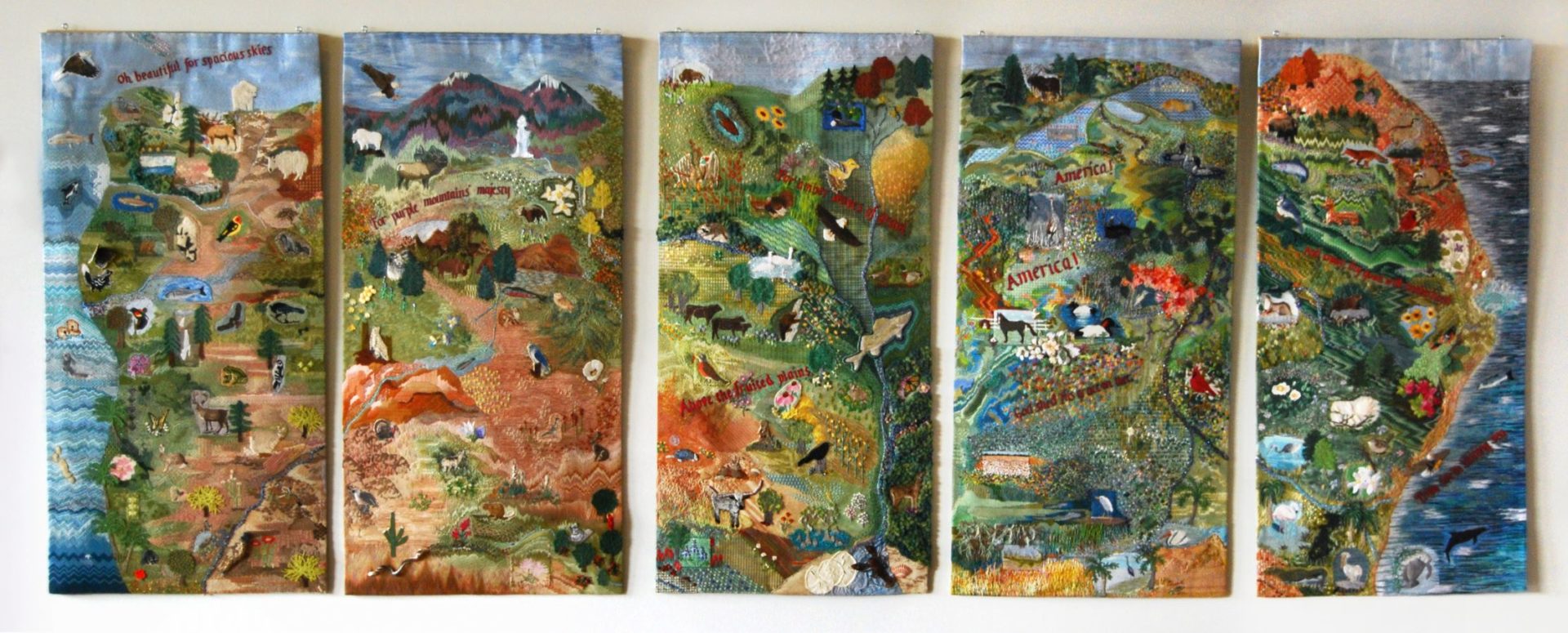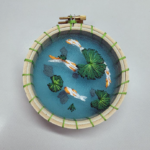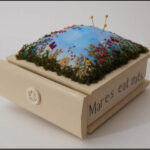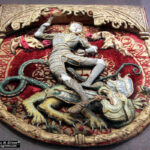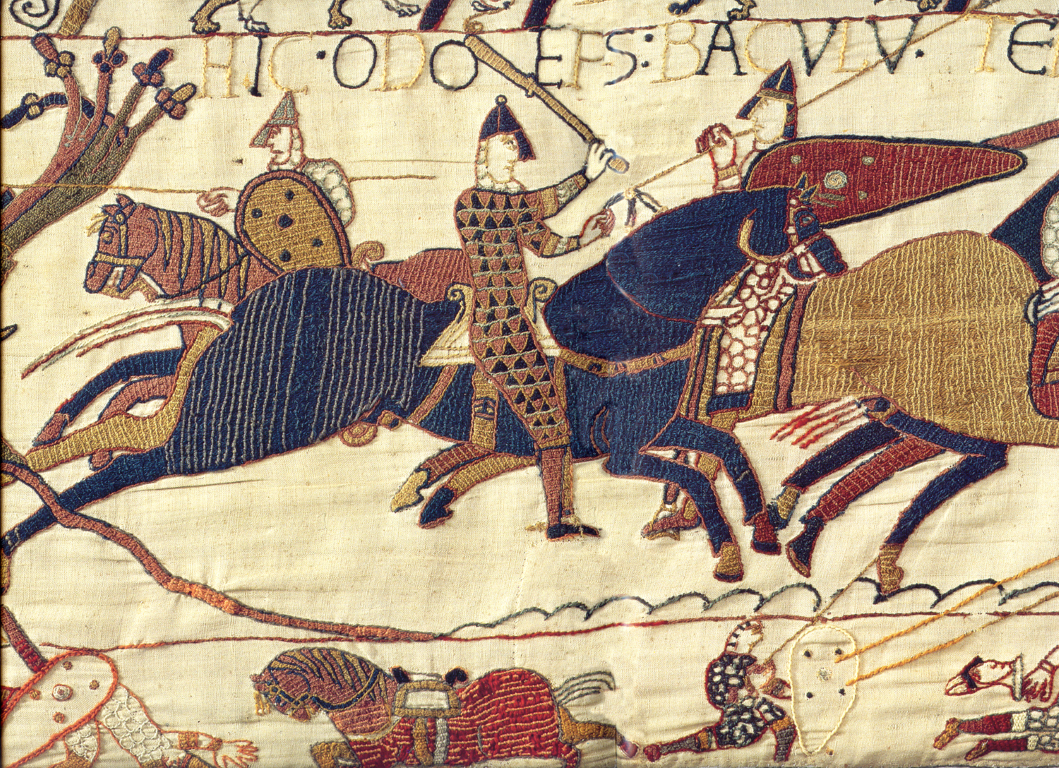
The Bayeux Tapestry has fascinated needleworkers and historians alike for centuries. Unlike most tapestries, which are woven, the Bayeux Tapestry was embroidered in stem stitch and couching, or Bayeux Stitch. Over the years, EGA has offered educational opportunities exploring the Bayeux Tapestry, such as our recent virtual lecture with Christine Crawford-Oppenheimer (learn more here). The history of the making and preservation of the Bayeux Tapestry, as well as the history it captures in its threads, tell a fascinating story about crafting as a means of storytelling and record keeping.
But the Bayeux Tapestry isn’t the only artifact of its kind. In fact, the Bayeux Tapestry has inspired a number of other similar needlework tapestries, all with the express purpose of capturing the history of various cultures around the world. Let’s uncover some of the tapestries created as a response to the Bayeux Tapestry.
The Plymouth Tapestry
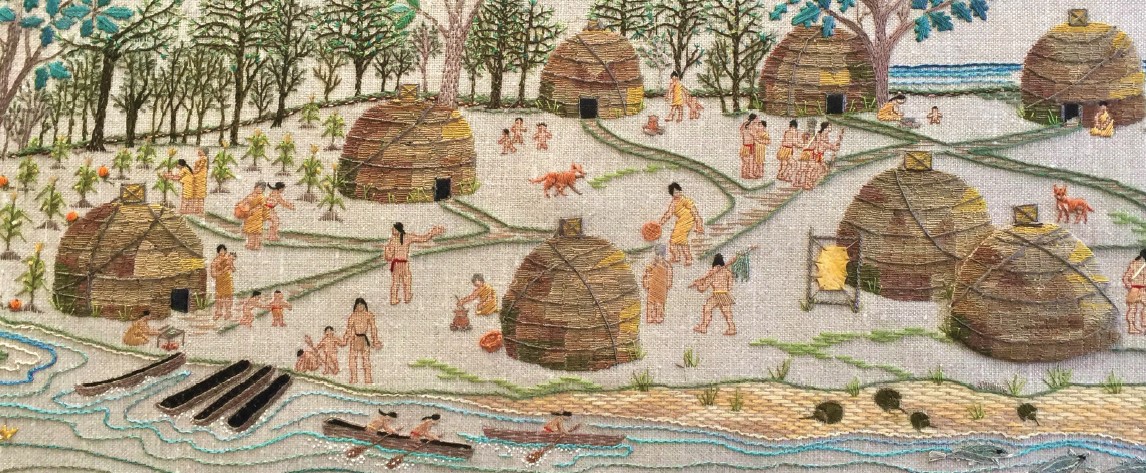
EGA explored aspects of the Plymouth Tapestry in the December 2018, September 202, and June 2023 issues of Needle Arts Magazine. Stewarded by Pilgrim Hall Museum, The Plymouth Tapestry aimed to expand on the classic tale of the 1620 founding of Plymouth Colony in New England to include more diverse perspectives, such as those of the native Wampanoag.
Spanning 20 panels, each six feet long, using wool and silk threads on linen canvas, the Plymouth Tapestry faithfully records the events and people that shaped the Plymouth Colony. In conjunction with Seminar 2023 Boston Stitch Party, we are offering attendees the opportunity to join us on a tour to the Pilgrim Hall Museum and the Wellingsley Studio of designer Elizabeth Creedan on Friday, September 1, 2023. Attendees will be able to view the tapestry up close and talk to some of the talented embroiderers working on the tapestry. Registration for the tour is via Seminar 2023 Boston Stitch Party, so look there for details. There are only a few seats left.
If you are interested in participating on this tour, please email Asst. Registrar Elizabeth Slomba at registrar2023@egausa.org.
We’ve also just scheduled a virtual lecture with Donna Curtin that explores the creation of the Plymouth Tapestry. Registration is open through September 8, 2023.
The Quaker Tapestry

The Quaker Tapestry resides in The Quaker Tapestry Museum in the United Kingdom. Started in 1981 and completed in 1996, the tapestry comprises 77 panels documenting Quaker life, from historically relevant Quakers to significant events, interests, and more. A total of 4,000 people assisted in the creation of the Quaker Tapestry, and like the Bayeux Tapestry, the embroiderers invented a special stitch to make the tapestry—the Quaker Stitch. You can see how to make the Quaker stitch below:
All 77 panels of the Quaker Tapestry are available to view online here.
The Keiskamma Tapestry

The Keiskamma Art Project has been fostering the creative works of the women of Hamburg, South Africa since 2000. The project began when Dr. Carol Hofmeyr moved to the seaside town and was taken aback by the poverty levels among the families there. The Keiskamma Art Project grew out of a desire to provide the women of Hamburg with a means of generating income with their embroidery.
The Keiskamma Tapestry was the first project produced by the collective, which now numbers 150+ women. In the 20 years since its inception, The Keiskamma Art Project has produced several tapestries and embroidered works of art. But the Keiskamma Tapestry was the first, and it set the tone for the many works of art to follow. The tapestry was sewn on donated wool, with individual women working on single panels at home. Over the course of three years, they stitched a tapestry measuring 394 feet long.
The tapestry relates the story of the Xhosa people of the Cape Provinces of South Africa and 300 years of the history of the Eastern Cape. Its beginnings depict the lives of the Xhosa, the colonial invasion by White settlers, the Xhosa British Frontier Wars, before it moves into the present day, depicting such historic events as South Africa’s first democratic election.
Take a virtual tour of the Keiskamma Art Project and Tapestry here.
The Ros Tapestry

Begun in 1988, the Ros Tapestry consists of 15 large tapestries, each depicting a significant event in the history of New Ross in the South East of Ireland. More than 150 volunteer stitchers have worked to complete the project.
The Ros Tapestry depicts the Norman heritage of South East Ireland and shows the history and way of life in 13th century Ireland. The tapestries exhibit crewelwork using a selection of stitches (seeding, chain stitch, couch stitch, long and short, stem stitch, French knots, bullion, and satin stitch) which are said to ”describe shape, volume and movement rather than the more traditional application of crewelwork techniques.” The Ros Tapestry features wool thread and Jacobean linen twill fabric—chosen for their durability and longevity. According to the Ros Tapestry website, “All the work is done from the front of the linen … It takes approximately 1 hour to stitch 1 square inch!”
View the 15 panels of the Ros Tapestry here.
The Last Invasion Tapestry

The Last Invasion Tapestry records the 1797 invasion of West Wales by the French. Designed by Elizabeth Cramp in 1993 to present in time for the bicentenary in 1997, the tapestry employed 77 local stitchers working on 37 separate cotton panels with 178 shades of crewel wool.
The entirety of the tapestry was completed by women, who finished the project over the course of four years. It’s apropos that women stitched the historical event—the myth of the Last Invasion posits that “the French were deceived into thinking they were facing a large British army when they saw red and black movements in the distance. In truth, these were said to be local women in traditional red shawls and black hats marching around a prominent hill in Fishguard.”
The Last Invasion Tapestry measures 100 feet long and features the same stitches medieval embroiderers would have used, just like the Bayeux Tapestry.
Learn more about the Last Invasion Tapestry.
The Apocalypse Tapestry
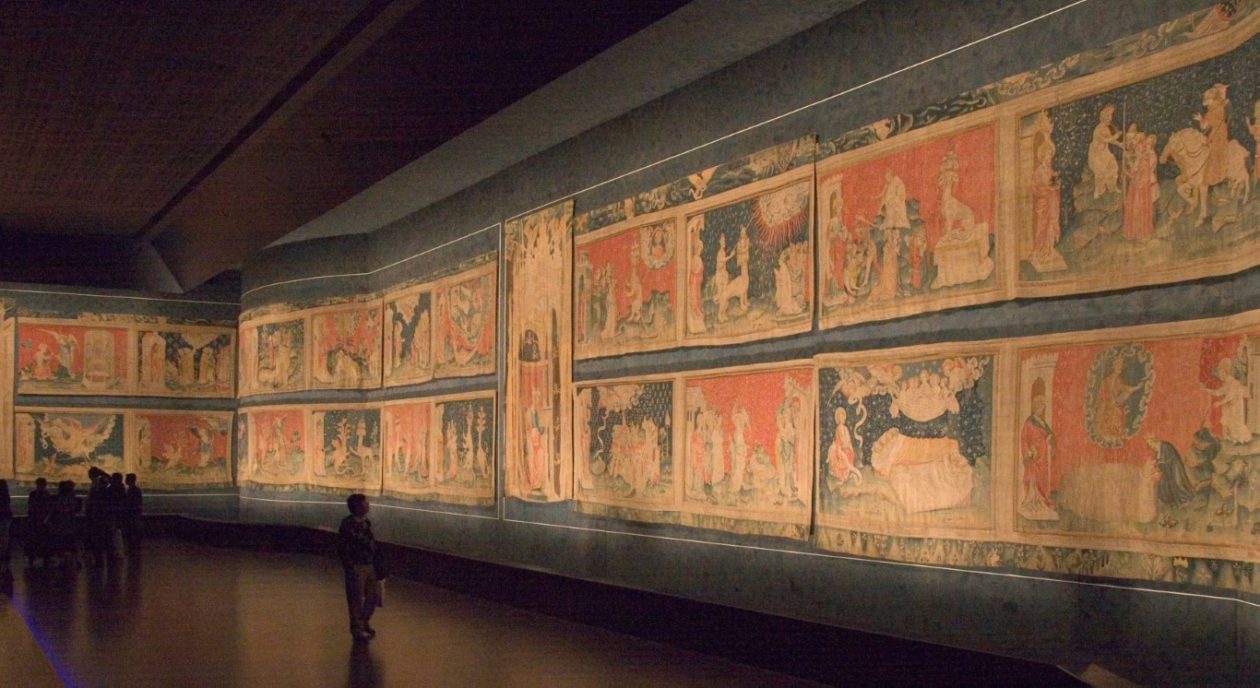
We’ve made a point to only include embroidered—not woven—tapestries on this list. However, we’ve made a special exception for the Apocalypse Tapestry given its import, and the fact that few crafters are even aware of its existence!
Commissioned by Louis I in the 14th century, the Apocalypse Tapestry was woven between 1377 and 1382 and shows the Apocalypse as told in the Book of Revelation. It comprises 100 separate tapestries in gold, red, and blue wool thread and is the largest medieval tapestry in the world. Completed sans envers (without a reverse), the tapestry is reversible, with both sides displaying the work.
Like the Bayeux Tapestry, it was kept in a chest and rarely shown in public. During the French Revolution, the tapestry was looted, cut into pieces, and the pieces used as mats, orange tree insulation, plugs for holes in buildings, and even as stable blankets for horses. Eventually, the tapestry was restored, with only 16 pieces missing. It originally measured 460 feet long and 19.5 feet high. The surviving tapestry now measures 328 feet long; of the original 90 scenes, 84 scenes have been preserved.
The Apocalypse Tapestry is currently displayed in a gallery in the Château d’Angers in France. Learn more about the Apocalypse Tapestry here.
The Great Tapestry of Scotland
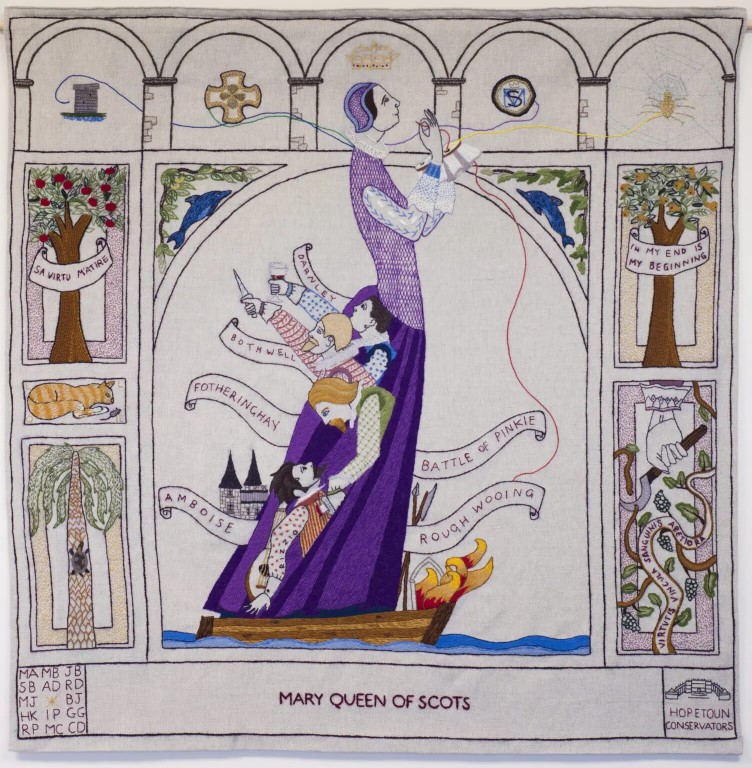
As the website proudly states, it took 1,000 stitchers working for 50,000 hours of sewing with 300 miles of wool—enough to stretch the length of Scotland!—to create the Great Tapestry of Scotland.
The brainchild of British author Alexander McCall Smith (The No. 1 Ladies’ Detective Agency series, the 44 Scotland Street series) and artist Andrew Crummy, the Great Tapestry of Scotland depicts a wealth of Scottish history, culture, land and people. (Crummy is the son of Helen Crummy, who designed the Battle of Prestonpans Tapestry and the Scottish Diaspora Tapestry). Comprised of 160 linen embroidered panels, it’s entirely possible to learn the history of Scotland through viewing the Great Tapestry of Scotland. Key events in Scottish history are narrated beautifully in the embroideries, from the ice age when the land form to the Vikings to the Jacobite rebellion and on.
Learn more about the Great Tapestry of Scotland.
The Palestinian History Tapestry
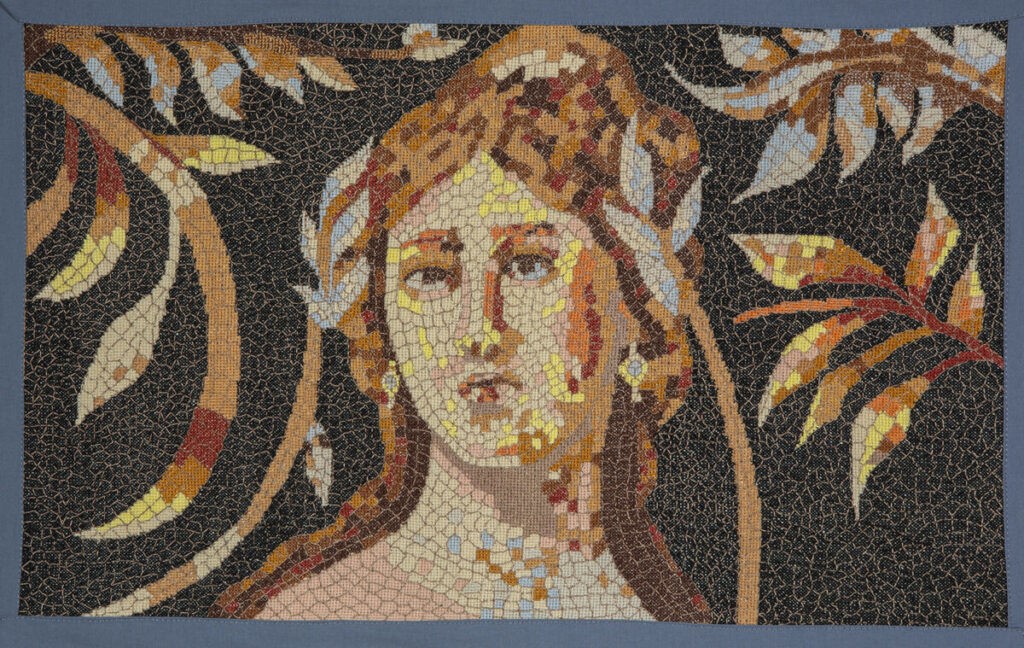
The Palestinian History Tapestry offers a holistic representation of Palestinian history, from the Neolithic period up through the Nakba of 1948 and the present age. Featuring traditional Palestinian embroidery techniques like tatreez, the tapestry shares some history with the Keiskamma Tapestry. Jan Chalmers, who taught embroidery to South African women on the Keiskamma Art Project, proposed a Palestinian Tapestry after her work on the Keiskamma Tapestry.
Palestinians from Gaza, Galilee, Bethlehem, Nablus, Ramallah, Hebron, the Naqab, Deheisheh, Lebanon, and in refugee camps in Jordan participated in the creation of the panels, each of which measures no more than 1 meter in length. The tapestry consists of 101 panels, but according to the website, the work is ongoing. “Palestinian embroiderers will continue to be commissioned to stitch additional illustrative panels relevant to events and themes, from the Neolithic period to the present. The Palestinian Subcommittee for Panel Image Selection, will remain responsible for prioritizing additional images for stitch.”
View the panels of the Palestinian History Tapestry.
We hope you enjoyed this overview of historical tapestries similar to the Bayeux Tapestry. We recognize this is not an exhaustive list, and encourage stitchers to let us know about their favorite tapestries on our social media channels!
The National Tapestry – America the Beautiful
A list of tapestries inspired by the Bayeux Tapestry would be incomplete without EGA’s very own National Tapestry – America the Beautiful.
Designed and painted by EGA member Judy Jeroy, the National Tapestry required the stitchwork of thousands of EGA members over the course of five years to complete. The National Tapestry is composed of five 2-foot by 4-foot high sections, each stitched to represent a different locale with its indigenous flora and fauna. Each panel includes wording from America the Beautiful and features a selection of different embroidery techniques. Beading traces the rivers, and trees were stitched individually then placed in their appropriate zones. The tapestry features many slips created by embroidery artists that were added to the tapestry after completion.
A piece of art created from the rich tapestry of needleworkers in the United States, the National Tapestry is a true representation of the beauty we can create when we work together. America the Beautiful is currently on display at EGA headquarters—visit us in Louisville, Kentucky, to see it in person!
We hope you enjoyed this overview of historical tapestries similar to the Bayeux Tapestry. We recognize this is not an exhaustive list, and encourage stitchers to let us know about their favorite tapestries on our social media channels!
Like this post? Pin it!
